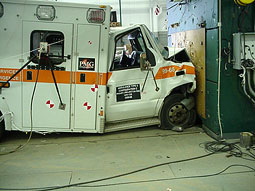Emergency Medical Services (EMS) Responder Safety
Emergency Medical Services Responder Safety Study
In partnership with the Department of Homeland Security Office of Health Affairs, the USFA will perform a study of critical health and safety issues for EMS responders and incorporate the findings into revisions of EMS Safety - Techniques and Applications (PDF, 2.3 Mb, January 1997) and the Guide to Developing and Managing an Emergency Service Infection Control Program (PDF, 4.7 Mb, March 1992, updated January 2002).
With numerous injuries and fatalities to on-duty EMS responders, the safety and health of responders is a critical issue for both fire departments and third service EMS providers.
However, since the release of these two documents, there have been changes and updates in the area of the EMS provider safety and health, including infection control and other findings from numerous related USFA research efforts in emergency responder health and safety. In order for USFA to effectively serve its constituents in this area, the most up to date information regarding EMS responder health and safety, including infection control for local-level EMS and fire departments, will be incorporated into one revised and consolidated document.
USFA Partnership with the National Institute for Occupational Safety and Health on Emergency Services Vehicle Occupant Safety

Ambulance after 30 mile per hour barrier test.

Crash test dummies inside ambulance patient compartment.
USFA partnered with the National Institute for Occupational Safety and Health (NIOSH) to support their Evaluation of Emergency Services Vehicle Occupant Safety, a project which addresses ambulance and EMS vehicle safety.
The project outfitted an ambulance with two types of vehicle occupant restraints. Project objectives included the analysis of crash data for ambulance and EMS vehicles utilized by firefighters and emergency responders; a review of data on ambulance crash statistics; hazard identification and task analysis; determination of appropriate crash testing methodologies; development of occupant restraint systems; and modeling of ambulance crash scenarios. Human factors affecting the task performance of EMS workers in ambulance patient compartments were also analyzed.
Related Content






